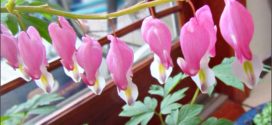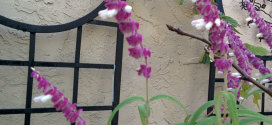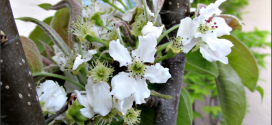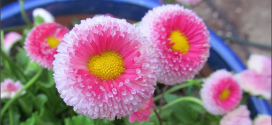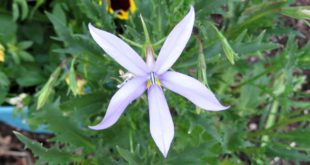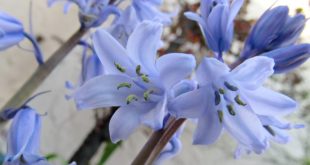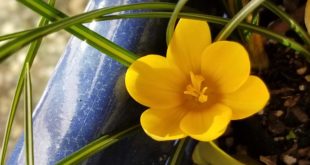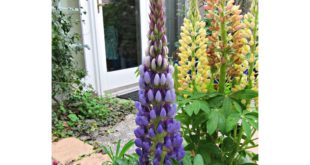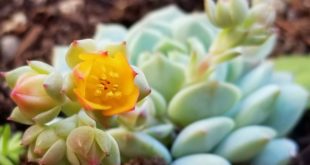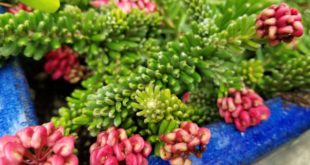The bleeding heart plant (Lamprocapnos spectabilis) has heart-shaped flowers that hang in rows on arching stems above soft, green foliage. This spring-blooming perennial has a short growing season. By midsummer, the whole plant dies back to the ground. Bleeding heart is hardy in U.S. Department of Agriculture (USDA) plant hardiness zones 3 through 9. Common Name: bleeding heart Type: Herbaceous …
Read More »Tag Archives: Spring
Salvia leucanthus – Mexican bush sage
Mexican bush sage (Salvia leucantha) is a beautiful, hardy plant for Alta California. This downy, bushy, evergreen subshrub produces white or purple flowers clasped by soft purple calyces from late summer to frost. It grows 3 feet tall by 3 feet wide, and is great for the border. Salvias are some of the showiest plants for containers, annual borders, and …
Read More »Asian Pear
Asian pear (aka Chinese, Japanese, Oriental, sand and apple pear). They are not apples. There are several differences between Asian pears and the more common European pear. Asian pears reach optimum quality when allowed to ripen on the tree, similar to apples and peaches. European pears are usually harvested in a green stage and allowed to ripen at room temperature. …
Read More »English Daisy
English Daisies look like tiny daisies. Technically a perennial, English daisy is usually best treated as a biennial (it takes two years to bloom and then dies in the fall) in the South and an annual in the North. Plants survive down to about 10 degrees F so they can be planted in the fall in the South for early-spring …
Read More »Isotoma Starshine Blue
New to our Sunnyvale garden in 2020 is Isotoma ‘Starshine Blue’ Laurentia. It features showy powder blue star-shaped flowers with lavender overtones rising above the foliage from late spring to early fall. Its attractive deeply cut ferny leaves remain dark green in colour throughout the season. Starshine Blue Laurentia is often used as a ‘filler’ in the ‘spiller-thriller-filler’ container combination, …
Read More »March in Our Sunnyvale Garden – 2019
Our Sunnyvale garden in March 2019 was filled with flowers.Spring blossoms on the plum, apricot, and orange trees. Spring bulbs like Crocus, Freesias, Grape-Hyacinth, Hyacinth, Tulips, Dutch Iris, and Spanish Bluebell. Spring vegetables like snowpeas and kale. Excellent cool-season annuals with Violas and Pansies. Rainy-season perennials like Cyclamen, India Hawthorne, Lewisia, Verbinium, Geranium, Rosemary and Lavender. Lots of foliage on …
Read More »Crocus vernus
This variety is one of the familiar, and welcome, giant spring Crocus, which are colorful companions for early Daffodils. They are terrific for bedding, rock gardens, shrub borders, and naturalizing in grass. Reserve a few bulbs to pot up and force, and you will soon be the bearer of sweet little gifts that are inexpensive yet rich with the promise …
Read More »Lupines
New to our Sunnyvale garden in 2019 are lupines. They are spectacular in the garden and in the nature. Choose a sunny site with average, well-draining soil. Lupines are legumes and can improve a soil’s fertility over time. Light: Full sun is preferred. Lupine can grow in part shade, but flowering will be lessened. Soil: Lupine needs well-draining soil above …
Read More »Echeveria derenbergii – Painted Lady
New to our Sunnyvale garden in 2019… Echeveria derenbergii is an evergreen perennial succulent with a basal rosette of pagoda-shaped, frosted, fleshy leaves colored silvery-blue with bristly tips. In winter it bears clusters of bell-shaped yellow flowers with red tips . Echeveria aggressively offsets from a young age, forming clusters quickly. Short arching racemes of golden-yellow flowers with red tips …
Read More »Grevillea lanigera
New to our Sunnyvale garden in 2019 is Grevillea lanigera – A low, dense ground cover/shrub to grows to 2 feet tall and 4 feet wide with small, narrow gray-green foliage that is soft and woolly. I have planted ours in a tall container with the hope that the long branches will hang. The cream and pink flower clusters form …
Read More »